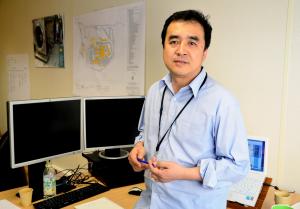Let there be light!
28 May 2013
-
Robert Arnoux
Like he did at KSTAR in 2008, Woong Chae will manage the long and complex commissioning phase of the ITER Tokamak.
Once the components of the ITER Tokamak are assembled and individually verified, a delicate and complex series of operations will be necessary before lighting the fire of First Plasma.
Commissioning, as this phase is called, means that all the different systems of the machine—vacuum, cryoplant, magnets—will be tested together in order to verify that the whole installation behaves as expected.
These commissioning operations all converge toward one point: the breakdown of the gas inside the vacuum vessel.
It happens in the following way: Initially, the toroidal field coils are electrically charged. Then the varying electrical current in the central solenoid and poloidal field coils generates an electric field around the torus of the tokamak causing the atoms in the gas to collide with the accelerated electrons. The gas in the vacuum vessel becomes ionized (electrons are stripped from the atoms) and reaches the state of plasma.
"At this moment," explains Woong Chae Kim who joined ITER two months ago as Section Leader for Commissioning and Operations, "First Plasma will be achieved and the commissioning process will be over."
ITER commissioning is expected to last more than two years and every step—from vacuum vessel leak-testing to the electrical charging of the magnets—will bring its own challenges. Woong Chae, however, is confident. "In the long history of tokamaks, start-up operations have never failed. Technically, I am not afraid. I've done it before ..."
"Before" was five years ago, when Woong Chae was in charge of plasma commissioning at KSTAR. On 13 June 2008, following six months of commissioning operations, the large Korean tokamak (and the first to implement superconducting niobium-tin coils) achieved a First Plasma that surpassed the original target parameters.
From a technical perspective, commissioning KSTAR was close to what it will be at ITER. The difference lies in the regulatory status of the two devices—ITER is a nuclear installation, KSTAR is not—and in the inner workings of the organization.
"I participated in several design reviews for ITER components over the past four years and have had many opportunities to experience the complexity of the decision-making process within the ITER Organization. It is indeed a very complex machinery, even more than I had anticipated ..."
KSTAR, which he joined in 1995 when the project was launched, taught something essential to Woong Chae: "While doing your own job on your own system or component, it is essential to have an overview of the whole device. If you don't, coordination and interfacing becomes very, very difficult ..."
Woong Chae chose to train as a fusion physicist/engineer because he felt fusion was "cool." "It's ideal as an energy-producing source, fascinating in terms of physics and technology and so different from the things one comes across in daily life."
The first fusion device he encountered at graduate school in Seoul was the small tokamak SNUT-79 that Korea had developed in the late 1970s—the country's first significant step onto the fusion stage. At the time, says Woong Chae, "the device was already a museum piece standing at the centre of the laboratory." He then worked on the mirror machine HANBIT ("Great Light") in Daejeon, a partial reincarnation of the MIT's 25-metre-long TARA, where he "learned how to manage big projects."
After spending 18 years at KSTAR, Woong Chae felt that ITER was the "natural playground" for people like him—people who thrill at the challenge of "organizing men and procedures in order to make things happen." Several ITER colleagues like Chief Engineer Joo Shik Bak or CODAC Section Leader Mikyung Park made a similar choice.
Woong Chae has moved to Aix-en-Provence with his wife, who spent a year in France as a graduate student, and their 16 year old son. They live near "Painters Ground" and have a beautiful view of Mount Sainte-Victoire. "Although I do not speak much French and am not what you would call a specialist in impressionism, I'm on familiar ground. In the early days of my marriage, we lived in Daejeon, close to restaurant named ... Cézanne."


